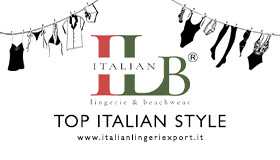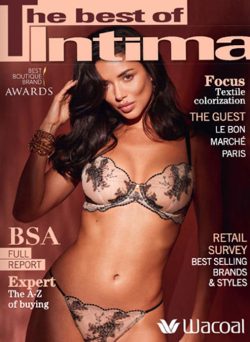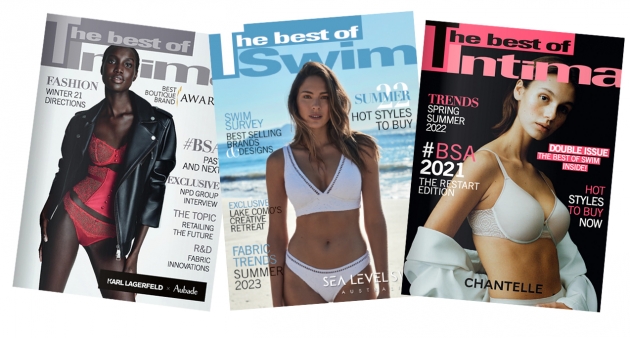
The Best ofIntima & Swim Edit
The A-Z of Buying- The Guide to Optimizing Your Purchasing – PART 1
17 September 2024
We have teamed up with Helen Masters of Pudding to provide readers online Masterclasses, here we begin exploring the first topic. Make sure to stay tuned to find out all about the upcoming program and take the opportunity to sign on to the Masterclasses!

Over the next two editions, Helen gives a taster of her Buying A-Z in two parts. Part 1, in this edition: For New Lingerie and Swimwear Buyers. Part 2, to follow: For Established Lingerie and Swimwear Buyers. If you are a start-up lingerie or swimwear retailer or an established buyer who is new to the lingerie or swimwear category, read on for Helen’s top tips on what to buy, how much to buy, when to buy, how to ensure what you buy sells and more!
I have spent the last 18 years of my life in the lingerie & swimwear industry: initially, as a top performing UK retailer and for the last 10 years as a business consultant and trainer to stores all over the world. One of the key things I have learned in that time is the formula for success – what makes the difference between a best-in-class lingerie or swimwear retailer and an average one.My Top 3 Factors?
1. A Knock Out Proposition, Consistently Delivered Well
2. A Relentless Focus on Operational Rigour
3. Brilliant Buying – that is the focus of this feature.
Undoubtedly one of the differences between best-in-class businesses and those who under-perform is their approach to buying. The buying task in lingerie and swimwear retail is more challenging than in virtually any other category of fashion, due to the sheer volume of SKUs (stock keeping units required. Developing a buying strategy which allows you to offer maximum choice of size, color, style and aesthetic without being over stocked is critical – and not easy.In fact, over–stocking, under-stocking, or stocking the wrong products (what I refer to as ‘death by stockroom’) is one of the biggest causes of failure or under performance amongst lingerie retailers and department stores. Buying enough (but not too much) of the right products; focusing on depth in the most popular sizes but having a broad enough range when that 28GG customer walks in; getting the color mix right; backing bestsellers but having something new every month; and keeping in budget.…these are all the challenges a buyer faces. As a new buyer to the category, it can feel overwhelming.
At Pudding, we have coached and trained buyers in stores all over the world, both new and established. We have successfully helped start-ups to save thousands of dollars by avoiding costly purchasing mistakes; transformed under-performing stores into top performers and turned around declining lingerie departments in national chain stores. Now, we have put everything we know into the ultimate manual for lingerie & swimwear buyers, exclusively available for Intima subscribers, and if you can’t wait to get your copy, here is a snapshot of our top tips for new lingerie and swimwear buyers.

Step 1 - Develop the financial budget that you have to spend for the business as a whole - this is the Open to Buy (OTB)
Set the OTB
The budget you are going to set should be based directly on what you expect to sell in the period you are buying for. This means before you start placing orders, you need to have worked through a high-level financial plan for your business, and answer 2 critical questions:1) What do you need to sell to deliver your target profit? 2) Do you believe you can sell this?
A simple formula for this is:
Target Retail Sales (including tax)
e.g. $30,000
Divided by target net mark-up (the mark-up you actually achieve e.g. accepting that not everything will be sold at full price)
e.g. 2.4 x
= Target wholesale cost of goods sold (excluding tax)
e.g. $12,500
Best in class established businesses aim to hold no more than 3 months’ stock, to optimize cash flow (i.e. avoid having lots of 38Bs in the store and no money to buy the 34Fs that customers keep asking for!) but will also order up to 6 months’ worth of seasonal ‘one shot’ lines that they cannot replenish. New businesses will often need to hold more stock in their first year while they build sales. This is because the minimum amount of stock needed for trial and to simply secure enough sales, is likely to exceed 3 months’ worth, once you have factored in all the styles you need and how many colors and sizes you need them in. The goal should be to hold no more than 6 months’ stock but realistically some businesses need to start with up to 12 months’ stock when they are new.

Allocate the OTB over the period you are buying for
The key here is not to spend all that budget at once! Divide the budget between:
SEASONAL: e.g. 20%
Seasonal lines that have to be ordered in advance and cannot be replenished, so need to be bought in the full-size range you expect to sell. These can be used as showpieces to add freshness, sell through quickly and enable you to move on to the next line, meaning you have new options each month. They may be one off colors of best-selling styles, high fashion or edgier options that attract attention but sell in lower volume. A key consideration is whether to buy these in depth or position them as ‘limited offer’? You will need to buy more than 1 per size in each color of each style if you want more than one customer to be able to buy it.
CONTINUITY: e.g. 50%
Ongoing lines that you can buy in smaller quantities and then replenish regularly. These are likely to be your safer bestsellers (they are continuity lines because they are your suppliers’ bestsellers.) Order your top sizes and colors here, then add the more peripheral colors and sizes as you gain confidence, or by special order for customers. This Just In Time approach to stock management can be lucrative for the bottom line and allows you to expand the range you offer customers while avoiding death by stockroom.
Just In Time Stock Management - example 1Customer loves the swimsuit in red sees it in size 12, needs size 14You encourage the customer to try the blue version in 14, it fits!You order the red version in 14, the customer pays a deposit – the stock is sold before you bought it! Just In Time Stock Management - example 2Customer A tries 32E balcony bra in white – needs 32F so orders that and pays a depositCustomer B tries 32E balcony bra in white – buys it and orders it in black and beige also1 bra held= 4 bras sold
REPLENISHMENT: e.g. 20%
This is budget that you do not spend until and unless you need to. It is held back to top up best-selling SKUS and pay for customer orders. The beauty of this is you only spend it on things that are selling so if the stock doesn’t sell you avoid wasting money on having too much of it.
OPPORTUNE: e.g. 10%
This is budget you keep aside to take advantage of end of line stock at discount that you can sell at full price or as a contingency against sales being lower than planned or lines selling faster than planned. It allows increased budget for replenishment or replacement lines when things are going well.
Be Realistic About What You Will Sell
Remember that you won’t sell everything you buy. If you did there would be no stock left in your store! It is sensible to buy an extra 25% above what you expect to sell, and to expect around 25% to be left at the end of the period you are buying for (your target residual stock.) Once the business is up and running, if your residual stock is higher than the target then you will need to reduce the OTB for the next buying season by this excess amount. The idea is that unless the stock you have left is totally unsellable (it can happen in the first year but our job is to make sure it doesn’t!), then you need to discipline yourself to sell through the stock you have rather than piling up more and more stock that ends up hidden away and leads to the dreaded ‘death by stockroom’.
Step 2 - Define the range strategy for each product category
The type of range you want to offer should be obvious if you have defined your proposition and undertaken customer & market research to ensure it appeals to your target customer. Start off with a strategic view of what you want to offer, based on knowing what your business is aiming to give to your target consumer.
Consider:
PRODUCT
• The specific category of products to offer: e.g. nightwear/lingerie/swimwear/leisure
• The brand mix your customers want e.g. premium and entry level; a mix of known brands and unknown brands; some level of exclusivity; your ‘anchor’ brands; the number of brands that allows choice for the consumer and avoids over-dependence on one supplier, but at the same time means you are an important customer to your suppliers and can command the best service and commercial terms
• The range of end uses you wish to offer (sexy, pretty everyday, designer, bridal etc. or simply one end use e.g. boudoir)
• The range of styles (e.g. bra types and brief types) and colors your customers need
• The size range you need to offer and forecast sales by size /product/color and projected brief sales to bra sales
• The balance of continuity products (‘stayers’) and one-off fashion products you need
PRICE
• Define the retail price position for the range as a whole - e.g. is it premium/mass market? entry through to luxury? how does it need to be priced versus your competitors? what will customers pay? should you adopt luxury or value price points?
• define the price range & key price points e.g. entry/mid/premium/luxury based on the anchor product (e.g. bras in the lingerie category) and forecast volume sales by price point
• Add entry level price hooks to draw people in
• Follow a good/better/best approach to the offering
• Consider the price ratios of supplementary products to the anchor product e.g. the ratio of brief prices to bra prices
RANGE MANAGEMENT
• Plan the phasing of your range to balance freshness with continuity of best sellers, spread out expenditure and consider seasonal factors
• Build a life span and markdown plan for each range e.g. a seasonal line may be planned to sell through in 12 weeks; so offered at full price for 8 weeks, then gradually marked down in the last 4 weeks to clear; plan the percentage markdown you’ll need to understand your net mark up
• Plan to track sales versus plan weekly
• Draft a plan to: 1) clear slow sellers e.g. use of price /time driven offers e.g. offer of the month/last chance to buy 2) generate sales spikes without cannibalizing e.g. bulk offers/ limited time vouchers

Step 3 - Define The Range Plan
This is where you turn the strategic intent into a range of products that you will buy, which will deliver on your proposition and meet your target customers’ needs. The range plan is often set out as a matrix which shows:
• How you will segment the products you offer and make the offering logical and relevant to customers, typically by price point and end use
• Which options are the most important to your customers and will have more budget allocation egg mid-priced basics
• Which are the best brands/products for each option? (remember some products will span categories e.g. fit into both ‘Pretty Everyday’ and ‘Boudoir’ depending on the customer)
Plot the retail price categories and price points you wish to offer against the needs (or end use ) you wish to meet for the customer. Then identify possible alternatives to consider for each option in the matrix; evaluate them and decide which to buy. This is where your trade show visits come in - if you go to a trade show with an understanding of which ‘boxes’ you need to fill, then you will make the best use of the time and stay focused on buying the product that will sell.
TOP TIPS FOR THE RANGE PLAN
• Some boxes will need more products than others – often the majority of options are in the middle boxes
• Don’t cannibalize – e.g. don’t have the best products at entry price point! This means you may not fill each box
• Every option needs to add something – if not, take it out
• Aim for a balance of one-off fashion versus continuity lines, with a bias to continuity to facilitate Just In Time management
• Avoid over-reliance on any one supplier but ensure you are buying enough from each supplier to be an important customer
• Aim for products that span more than one option (e.g. could be seen as Pretty Everyday or Boudoir depending on the customer) to maximize sales
• Consider the mix of garment size range, styles and colors you need

Step 4 - Build the Bottom up Budget
The OTB is a ‘top-down’ view of the budget you can spend. Once you start ordering products however, it is common to find you want to blow the budget! Why? Well, let’s say one of your customer needs is a moulded T shirt bra…To suit your range of customers, you may need it in:
· 4 colors: black, dark brown, beige and white or ivory
· 60 sizes: e.g. across 30-44 C-J cup
· 3 styles: a plunge; a full cup and a balcony style
That is a total of 720 units if you bought one of each size in each color of each style. At an average cost of $20 that is $14,400 on one range alone! The good news is you can dramatically cut the budget by buying only your top sizes initially and splitting the range across all these options (e.g. Top 15 sizes: 4 balcony nude, 4 plunge white, 4 full cup black, 3 other = 15 units, $300)If you don’t have the size or color or style needed, encourage the customer to try their sister size or a different color or style. They may simply buy that! If not, they will gain enough confidence to place an order for the size, color or style they want – and maybe even for several colors and styles! An example of ‘more bang, less bucks’ in action! For that reason, it is a good idea to allocate the OTB as far as you can to SKU level. This may feel painful and overly detailed BUT it is a critical step to ensure you have enough of the right stock and not too much of the wrong stock.Once you have defined your range plan, go back to the OTB and aim to split it by:
· Category (swimwear, lingerie etc.)
· Product within category (bra, briefs etc.)
· The size profile you need for each ANCHOR product (e.g. for the bra in the lingerie category) and how many you need of each size. You will sell more 34Fs than 40Bs for example so if you buy every bra in every size you will succumb to death by stock room!
· The coverage you need of any particular styles or colors (e.g. if you need 20 34Fs how many are balcony bars, full cup bras? how many are beige, brown, black, white?)
· The ratio to buy of linked products (e.g. briefs to bras)
Set a sensible budget before you buy anything and work out what everything you want will cost as you may need to make changes!

Step 5 - Develop individual orders; agree appropriate supplier terms and place orders in time
You are now ready to buy!
Simply overlay the target number of bras to buy by brand onto your Purchase Order or the order template from the supplier. Then work out the detailed bra styles you want to order by range, size and color, to total to the target. Calculate the number and sizes of linked items e.g. briefs to buy.

Be a brilliant Buyer and make sure you have selected suppliers whose terms and way of operating suit your business, and that you understand the detail of the contract. Refer to our buyer checklist in Figure 7 to avoid the common pitfalls!
Step 6 – Ensure It sells!
Your strategy to sell the range starts from the moment you buy it! As you order, sense check that you have new offerings each month, using a Range Schedule. Once you have placed your orders, develop your Stock Management Plan. This is a live document showing all the stock you have ordered and what you plan to sell each week/month. It is tracked against what you actually sell to assist in optimizing stock levels (neither over or understocked.) This means on a weekly or monthly basis you review sales to:
· Identify strong/poor performers
· Identify where remedial action may be needed
· Identify what remedial action to actually take
The stock management plan is a ley tool for best-in-class buyers to enable efficiency, effectiveness, maximum profitability and continuous improvement. Finally, develop the KPIs you need to track to ensure your buying is effective and make sure you know what good looks like! While the buying plan is, by necessity, detailed, its effectiveness can be tracked by monitoring some fairly simple key performance Indicators (KPIs.)

Tracking performance against plan and against industry standard KPIs will help you to know if the buying decisions you made were right and to continually improve your buying. It will also help you to know when you need to take action to improve profitability rather than waiting until after you have lost money! Finally, it will help you to see if the stock management tactics you use are working or not and continually improve those too. As a brilliant buyer, stock turn, sell through rates and gross and met margin will be your best buddies!
In Part 2 of our Buying A-Z, we will reveal everything you need to know about the Range Schedule, Stock Management Plan and KPIs – all with the goal to achieve Step 6-Ensure It Sells! In the meantime, check out our example Starter For 10 order, and you won’t go far wrong!

Copyright 2025. All right reserved - Terms








